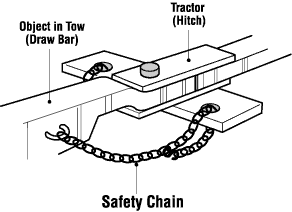Tractors - Trailers and Wagons
On this page
What precautions should you take when using trailers or wagons?
Back to top- Always read, understand and follow the manufacturer’s safety manual.
- Use a tractor with enough power to both pull and stop the load safely.
- Only use equipment that is in good repair. Equipment should be inspected frequently for signs of wear and damage.
- Check the tires on trailers and wagons for proper inflation, damage and wear daily, before loading, and throughout the workday.
- Use standard hand signals when someone is helping with hitching. Make sure you and the person you are working with have coordinated the signals.
- Use a locking jack, or jack and blocks, for hitching and unhitching a two-wheeled or tandem centre-balanced wagon.
- Use only recommended sizes and types of locking safety hitch pins.
- Attach the safety chain from the tractor to the frame of the towed equipment.
- The breaking strength of safety chains must be equal to hold the total actual weight of the towed implement and any load it is carrying.

- Distribute loads evenly and securely.
- Start and stop the tractor smoothly.
- Drive at a speed safe for conditions, load, and the capabilities of the tractor.
- Watch for low branches, eaves and power lines when handling high loads.
- Make sure the implements are put in transport positions before taking them on the road.
- If applicable, attach a slow-moving vehicle sign (red-orange, fluorescent triangle), red flag or marker, and any appropriate lighting and reflectors.
What should you not do?
Back to top- Do not overload.
- Do not allow anyone to ride on the tongue of a wagon or trailer.
- Do not allow anyone to ride on or in the wagon or trailer unless it is designed to transport passengers safely.
- Do not allow anyone to be between the tractor and wagon or trailer when in motion.
- Do not travel faster than 25 km/h.
- Do not drive over debris or obstacles that could damage the tires.
- Do not drive through ditches, steep banks, and other obstacles that could cause damage or a rollover.
- Do not tow wagons or trailers weighing more than the tractor unless the trailer or wagon is equipped with brakes appropriate for the weight and speed of travel.
- Fact sheet last revised: 2025-06-23

